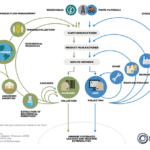
Have you ever wondered why some people seem to be able to achieve anything they set their minds to, while others appear to be stuck in a routine? The answer may lie in their mindset.
Growth mindset (GM) is the belief that intellectual ability can be developed (Yeager and Dweck, 2020), and our skills can be cultivated through hard work and effort. Individuals with a Growth mindset believe they can learn new things, improve their skills, and achieve their goals, regardless of their natural talent.
Growth mindset interventions are gaining popularity in education (Burnette et al., 2023), in businesses, and are also being applied in other areas, such as promoting environmental action (Duchi et al., 2020). Organizations want employees to enhance their skills, and companies like Microsoft are adopting interventions and growth mindset policies to encourage employee development (Rogers et al., 2023).
GM is the understanding that failure and challenges are opportunities for growth and learning, rather than indicators of fixed abilities. Whether at a personal or organizational level, implementing growth mindset strategies will enable you to achieve the success you are seeking.
In this article, we will explore the definition and benefits of adopting a Growth mindset, as well as provide you with a practical guide to cultivate this mindset for personal and professional success, including increased confidence, motivation, problem-solving abilities, and innovation.
Growth Mindset definition
Growth Mindset can be defined as the belief that intelligence, capabilities, and skills can be developed through dedication, effort, and perseverance.
In this regard, Dweck (2016) emphasizes that individuals who believe their talents can be developed (through hard work, good strategies, and input from others) have a “Growth Mindset.”
Thus, people with a GM believe they can learn new things, improve their skills, and achieve their goals, regardless of their natural talent.
Characteristics of growth mindset
Here are some key characteristics of a growth mindset:
- Belief in the power of effort: Individuals with a growth mindset believe that hard work and effort are the keys to success. They do not fear challenges and see them as opportunities to learn and grow.
- Focus on learning: People with a Growth mindset are always looking for new things to learn. They are curious and open to new experiences.
- Willingness to receive feedback: Individuals with a growth mindset are willing to receive feedback and use it to improve. They do not see feedback as criticism but as an opportunity to learn and grow.
Why is Growth Mindset important?
Adopting a growth mindset offers numerous benefits that can positively impact both your personal and professional life. Burnette et al. (2023) highlight that, despite the significant variation in the effectiveness of growth mindset initiatives, they found positive effects on academic outcomes, mental health, and social functioning, especially when interventions are administered to those expected to benefit the most.
Here are some key benefits of the growth mindset:
- Increased confidence: A GM fosters a sense of belief in your ability to learn and grow. As you overcome challenges and achieve your goals, your confidence naturally increases. You become more willing to take risks and step out of your comfort zone, knowing that failure is not a reflection of your abilities but rather an opportunity for growth.
- Greater motivation: People with a GM are more motivated to learn and achieve their goals. They view setbacks as temporary and believe in their ability to overcome obstacles through effort and perseverance. This intrinsic motivation drives them to continually improve and reach new heights.
- Enhanced problem-solving abilities: A GM encourages people to approach problems with a flexible and open mindset. They are more likely to seek creative solutions, explore different perspectives, and adapt their strategies as needed. This mindset fosters a problem-solving mentality that can lead to innovative thinking and better outcomes.
- Increased resilience: A growth mindset cultivates resilience by shifting the focus from failure to learning and growth. Individuals with a growth mindset are better equipped to bounce back from setbacks, adapt to change, and persevere in the face of challenges. This resilience allows them to navigate tough times and emerge stronger than before.
Examples of growth mindset
Here are some examples of individuals who have demonstrated a growth mindset:
- Michael Jordan: Jordan was not a natural talent in basketball. He was cut from his high school basketball team but never gave up on his dream of playing in the NBA. He worked hard and eventually became one of the greatest basketball players of all time.
- J.K. Rowling: Rowling was a single mother living on welfare when she wrote the first Harry Potter book. She was rejected by 12 publishers before Bloomsbury finally agreed to publish her book. Since then, the Harry Potter series has sold over 500 million copies and has been translated into 80 languages.
- Stephen Hawking: Hawking was diagnosed with amyotrophic lateral sclerosis (ALS) at the age of 21. He was given only a few years to live but went on to become one of the brightest physicists of our time. He made groundbreaking discoveries in the field of cosmology and wrote several highly successful books.
Growth Mindset vs. Fixed Mindset
Unlike a growth mindset, a fixed mindset is the belief that intelligence and abilities are fixed traits that cannot be changed. Individuals with a fixed mindset often avoid challenges out of fear of failure, as they believe failure reflects their inherent limitations. They tend to view effort as fruitless, thinking that either you have the ability or you don’t. This mindset can hinder personal and professional growth, as individuals may not fully explore their potential or take risks to achieve their goals.
The key difference between a growth mindset and a fixed mindset lies in how people perceive and respond to challenges and setbacks. While those with a growth mindset see challenges as opportunities for learning and growth, those with a fixed mindset tend to view challenges as threats to their own image. By shifting from a fixed mindset to a growth mindset, individuals can unlock their potential, overcome obstacles, and achieve greater success.
Cote (2022) provides an example to understand the differences between fixed mindset and growth mindset: “As an aspiring entrepreneur, you need basic financial skills to create your company budget and prepare your financial statements. If you have a fixed mindset, you might think, ‘I’ve never been good at math, let alone financial statements. I’m not cut out to run my own business.’ Whereas if you have a growth mindset, you would think ‘I have no experience in finance, but I can learn and practice those skills until I feel capable.'”
Below is a table summarizing the key differences between a growth mindset and a fixed mindset:
| Growth Mindset | Fixed Mindset |
|---|---|
| Believes skills can be developed through hard work and effort. | Believes skills are set in stone. |
| Focuses on learning and improvement. | Focuses on proving one’s worth and avoiding failure. |
| Views feedback as an opportunity to learn. | Regards feedback as criticism. |
How to Develop a Growth Mindset
Developing a growth mindset requires intentional effort and practice. Below are some strategies that will help you cultivate a GM in your life:
- Set Achievable Goals: Start by setting realistic and achievable goals that align with your interests and aspirations. Break down your objectives into smaller, manageable steps so that progress is more tangible and attainable. By setting goals, create a roadmap for growth and motivate yourself to take action.
- Embrace Failure as a Learning Experience: Instead of fearing failure, embrace it as an opportunity to learn and grow. Reflect on your failures and setbacks, identify the lessons learned, and use them to improve. Remember that failure is not a reflection of your abilities but rather a stepping stone to success.
- Seek Feedback: Actively seek feedback from others, whether mentors, colleagues, or friends. Be open to constructive criticism and use it as an opportunity to learn and grow. Feedback provides valuable information and helps you identify areas for improvement.
- Cultivate Resilience: Develop resilience by bouncing back from setbacks and persevering in the face of challenges. Resilience is the ability to adapt and recover from difficult situations and plays a crucial role in the development of a growth mindset. Practice self-care, engage in positive self-talk, and surround yourself with a support network to enhance your resilience.
- Reframe Failure: Instead of viewing failure as a negative outcome, reframe it as a learning opportunity. Adopt a growth mindset by asking yourself, “What can I learn from this experience?” and “How can I use this setback to improve?” By reframing failure as a springboard to success, you can bounce back stronger and better equipped for future challenges.
- Adopt a Problem-Solving Mindset: Challenges often require creative problem-solving skills. A growth mindset encourages you to approach challenges with curiosity and a willingness to explore different solutions. Break the problem into smaller parts, think of possible solutions, and be open to trying new approaches. With a GM, you can tackle challenges as opportunities for growth and find innovative solutions.
- Seek Support and Collaboration: Don’t be afraid to seek support and collaborate with others when facing challenges. Surround yourself with a network of mentors, colleagues, or like-minded individuals who can provide guidance, advice, and encouragement. By leveraging collective wisdom and experiences, you can find support and insights that can help you overcome even the most overwhelming challenges.
By implementing these strategies in your daily life, you will gradually shift towards a growth mindset and unlock your full potential, as well as that of your organization.
Growth Mindset in Education
The concept of a growth mindset has significant implications for education, where it originated. When students adopt a growth mindset, they become more motivated, engaged, and resilient learners. Research by Yeager and Dweck (2020) demonstrated that the foundations of mindset theory are robust, the effects are replicable and promising, and there is a challenge in creating the right context to apply them to students.
Yeager et al. (2019) reported that a brief online intervention on a GM improved grades among low-performing students and increased enrollment in advanced math courses in a sample of high school students in the United States.
Here are some ways to apply a growth mindset in education:
- Teach the Power of Yet: Encourage students to use the word “yet” when facing challenges or setbacks. For example, instead of saying “I can’t solve this math problem,” encourage them to say “I can’t solve this math problem yet.” This subtle language shift instills the belief that with effort and perseverance, they can overcome any obstacle.
- Provide Constructive Feedback: Offer specific and constructive feedback that focuses on effort, growth, and improvement. Highlight areas where students have shown progress and provide guidance on how they can further develop their skills. This feedback reinforces the idea that skills can be developed through practice and encourages students to embrace challenges as growth opportunities.
- Create a Safe and Supportive Learning Environment: Foster a classroom environment where mistakes are seen as learning opportunities, and effort is valued more than immediate success. Encourage collaboration, risk-taking, and open discussions. Create opportunities for students to reflect on their learning journey and celebrate their progress. By creating a safe and supportive learning environment, students feel empowered to take risks, learn from failures, and cultivate a growth mindset.
- Teachers and the Growth Mindset: Research results from Ng (2018) emphasize that teachers should also adopt a growth mindset, enabling them to understand the importance of providing autonomy over students’ learning to enhance self-regulation. As a result, students will be more motivated to learn subjects in school, rather than relying on the assumption that they will be interested in learning. Similarly, Mesler et al. (2021) revealed that teachers with a growth mindset have a slightly positive and statistically significant association with the development of their students’ growth mindset, particularly in the case of children.
Applying a growth mindset in education not only improves students’ academic performance but also enhances equality. It provides them with the skills and mindset necessary for lifelong learning and personal growth. Ng (2018) also emphasizes that ‘Educating students about the growth mindset and how they can improve their learning experience is a step toward greater intrinsic motivation in our society. From a personal perspective, intrinsic motivation is the key substrate for learning and development.’
Growth Mindset in Businesses
The power of a growth mindset extends beyond the realm of education and reaches the workplace and companies. By cultivating a growth mindset in the workplace, individuals and organizations can unlock their full potential. Additionally, a GM at work makes employees more oriented towards others and more likely to help (Rogers et al., 2023).
Dweck (2016) indicates that when an entire company adopts a growth mindset, its employees report feeling more empowered and engaged. Johnston (2017) predicts that companies with a growth mindset will outperform those with a fixed mindset. Changing the mindset is not too complex, but it requires impeccable implementation with human resources leaders at the forefront.
On the other hand, the results of the study by Canning et al. (2020) highlight that employees who perceived their organization supported a fixed mindset (as opposed to a growth mindset) reported that their company culture was characterized by less collaboration, innovation, and integrity. They also reported less trust and organizational commitment.
Here’s how to foster a growth mindset in companies:
- Encourage Continuous Learning: Foster a culture of learning within the organization by providing professional development opportunities, training, and skill development. Encourage employees to set learning goals and provide resources and support to help them achieve those goals. By valuing and investing in continuous learning, an environment is created that promotes a growth mindset.
- Recognize Effort and Growth: Recognize and celebrate employees’ efforts, achievements, and growth. Highlight examples of employees who have overcome challenges and adopted a growth mindset. By recognizing and rewarding growth mindset behaviors, the importance of continuous improvement is reinforced, encouraging others to adopt a similar mindset.
- Promote Collaboration and Feedback: Create opportunities for collaboration and feedback among team members. Encourage employees to seek feedback from their peers, superiors, and subordinates. Emphasize the importance of constructive feedback as a catalyst for growth and improvement. By fostering a culture of collaboration and feedback, an environment is created that supports and encourages a growth mindset.
- Lead by Example: Leaders play a crucial role in cultivating a growth mindset within the organization. Lead by example by accepting challenges, seeking feedback, and demonstrating a commitment to continuous learning. Share personal stories of failures and setbacks, highlighting the lessons learned and the growth that resulted from those experiences. By modeling a growth mindset, leaders inspire and motivate their teams to adopt a similar mindset.
By cultivating a growth mindset in the workplace and companies, organizations can foster innovation, resilience, and personal development among their employees. This mindset creates an environment that encourages collaboration, continuous learning, and adaptability, ultimately leading to greater success.
Growth Mindset for Entrepreneurship
The power of a growth mindset is an important tool for entrepreneurs because it prepares them to face the failures, risks, and challenges on the path to success.
Billingsley et al. (2023) studied ‘growth mindset in entrepreneurship,’ determining that it underlies five distinct measures of mindset closely related to entrepreneurship: leadership mindsets, creativity mindsets, person mindsets, intelligence mindsets, and entrepreneurial capacity mindsets.
On the other hand, Cote (2022) describes four reasons why entrepreneurs need a growth mindset:
- Allows you to venture into new fields.
- Fosters resilience.
- Enables iteration on your product.
- Keeps you humble.
Books and Resources to Help Develop a Growth Mindset
There are numerous books and resources available to help individuals develop and cultivate a GM. Here are some recommendations:
- ‘Mindset: The New Psychology of Success’ by Carol S. Dweck: In this groundbreaking book, renowned psychologist Carol S. Dweck explores the concept of a growth mindset and its impact on personal and professional success. Drawing on decades of research, Dweck provides practical strategies for developing a growth mindset and overcoming the limitations of a fixed mindset.
- ‘Grit: The Power of Passion and Perseverance’ by Angela Duckworth: In this book, Angela Duckworth explores the power of grit, a combination of passion and perseverance, and its role in achieving long-term success. Duckworth delves into the mindset and behaviors that enable people to overcome challenges and reach their goals.
- ‘Mindset Mathematics: Visualizing and Investigating Big Ideas, Grade 6’ by Jo Boaler: This book, aimed at educators and parents, offers practical strategies for cultivating a growth mindset in math education. It provides activities and teaching methods that promote a growth mindset and help students develop a deeper understanding of mathematical concepts.
These books, along with various online resources and courses, can provide valuable insights and practical strategies to help individuals develop and foster a growth mindset.
Conclusion
A growth mindset is the belief that intelligence, abilities, and skills can be developed through dedication, effort, and perseverance. It is the understanding that failure and challenges are opportunities for growth and learning, rather than indicators of fixed skills. With a growth mindset, individuals believe that their potential is not predetermined and that they can continuously improve and expand their capabilities.
Embracing the power of a growth mindset can transform your personal and professional life. If you believe in your ability to learn and grow, embrace challenges, seek feedback, and cultivate resilience, you can unlock your full potential and achieve remarkable success. Whether in education or the workplace, a growth mindset fosters continuous learning, innovation, and personal development. Therefore, take the first step today to cultivate a growth mindset and embark on a transformative journey of self-discovery and growth. The possibilities are endless when you embrace the power of a growth mindset.
A growth mindset is a powerful tool that can help you achieve your goals in life. If you want to develop a growth mindset, focus on challenging yourself, emphasizing learning, and seeking feedback.
References
Billingsley, J., Lipsey, N.P., Burnette, J.L. et al. Growth mindsets: defining, assessing, and exploring effects on motivation for entrepreneurs and non-entrepreneurs. Curr Psychol 42, 8855–8873 (2023). https://doi.org/10.1007/s12144-021-02149-w
Burnette, J. L., Billingsley, J., Banks, G. C., Knouse, L. E., Hoyt, C. L., Pollack, J. M., & Simon, S. (2023). A systematic review and meta-analysis of growth mindset interventions: For whom, how, and why might such interventions work? Psychological Bulletin, 149(3-4), 174–205. https://doi.org/10.1037/bul0000368
Canning, E. A., Murphy, M. C., Emerson, K. T. U., Chatman, J. A., Dweck, C. S., & Kray, L. J. (2020). Cultures of Genius at Work: Organizational Mindsets Predict Cultural Norms, Trust, and Commitment. Personality and Social Psychology Bulletin, 46(4), 626-642. https://doi.org/10.1177/0146167219872473
Cote Catherine. 2022. GROWTH MINDSET VS. FIXED MINDSET: WHAT’S THE DIFFERENCE? Harvard Business School Online.
Dweck Carol. 2016. What Having a “Growth Mindset” Actually Means. Harvard Business Review.
Duchi, L., Lombardi, D., Paas, F., & Loyens, S. M. (2020). How a growth mindset can change the climate: The power of implicit beliefs in influencing people’s view and action. Journal of Environmental Psychology, 70, 101461.
Johnston, I. (2017), “Creating a growth mindset“, Strategic HR Review, Vol. 16 No. 4, pp. 155-160. https://doi.org/10.1108/SHR-04-2017-0022
Mesler, R. M., Corbin, C. M., & Martin, B. H. (2021). Teacher mindset is associated with development of students’ growth mindset. Journal of Applied Developmental Psychology, 76, 101299.
Ng, Betsy. 2018. “The Neuroscience of Growth Mindset and Intrinsic Motivation” Brain Sciences 8, no. 2: 20. https://doi.org/10.3390/brainsci8020020
Rogers, B. A., Christian, J. S., Jennings, R. E., & Lanaj, K. (2023). The growth mindset at work: will employees help others to develop themselves? Academy of Management Discoveries, 9(1), 67-92.
Yeager, D.S., Hanselman, P., Walton, G.M. et al. A national experiment reveals where a growth mindset improves achievement. Nature 573, 364–369 (2019). https://doi.org/10.1038/s41586-019-1466-y
Yeager, D. S., & Dweck, C. S. (2020). What can be learned from growth mindset controversies? American Psychologist, 75(9), 1269–1284. https://doi.org/10.1037/amp0000794





